文博信息
缅甸历史文化遗产震后速报 | 因瓦古城宝迦雅寺
摘要: 缅甸历史文化遗产震后速报 | 因瓦古城宝迦雅寺原创AAHM亚洲遗产管理学会2025年04月02日 20:49江苏Express News缅甸历史文化遗产震后速报引言 | Foreword2025年3月28日发生的7.9级强震致使缅甸遭遇重大损失,据最新通报,截至4月2日,缅甸28日发生的强震已造成2886人遇难,另有4639人受伤,约373人失踪,我们向所有遇难者致以沉痛的哀悼。地震也对缅甸曼德 ...
缅甸历史文化遗产震后速报 | 因瓦古城宝迦雅寺原创 AAHM 亚洲遗产管理学会 2025年04月02日 20:49 江苏
Express News
缅甸历史文化遗产震后速报
引言 | Foreword
2025年3月28日发生的7.9级强震致使缅甸遭遇重大损失,据最新通报,截至4月2日,缅甸28日发生的强震已造成2886人遇难,另有4639人受伤,约373人失踪,我们向所有遇难者致以沉痛的哀悼。地震也对缅甸曼德勒-实皆-内比都沿线众多的文化遗产造成了毁灭性打击,约670座寺庙损毁、290座佛塔倾覆,曼德勒皇宫、马哈牟尼佛寺、梅努寺、阿瓦大桥等重要建筑损毁严重或变为废墟。数百座佛塔、寺庙坍塌,人类共同文化遗产存续正面临严峻考验。
为此,亚洲遗产管理学会特发布系列“缅甸历史文化遗产震后速报”,呼吁全球社会关注缅甸历史文化遗产的珍贵价值及震后损毁情况,共同守护人类文明的瑰宝。
02
宝迦雅寺震后速报
Post-earthquake Express News of Bagaya Kyaung Monastery
“
01 遗产概况
宝迦雅寺(Bagaya Kyaung Monastery)是一座柚木构筑的寺庙,位于因瓦古城外城中部。据考,该寺始建于阿瓦王朝的明恭(1401-1422)统治时期,但现存建筑建成时间可追溯到19世纪早中期。宝迦雅寺的屋顶有三层,寺内尖顶有七层。整个寺庙由267根柚木柱支撑,最大的柚木柱周长约3米,所有柱子的高度都相同,约为18米。寺院的结构相对宽敞,长约57米,宽约31米。
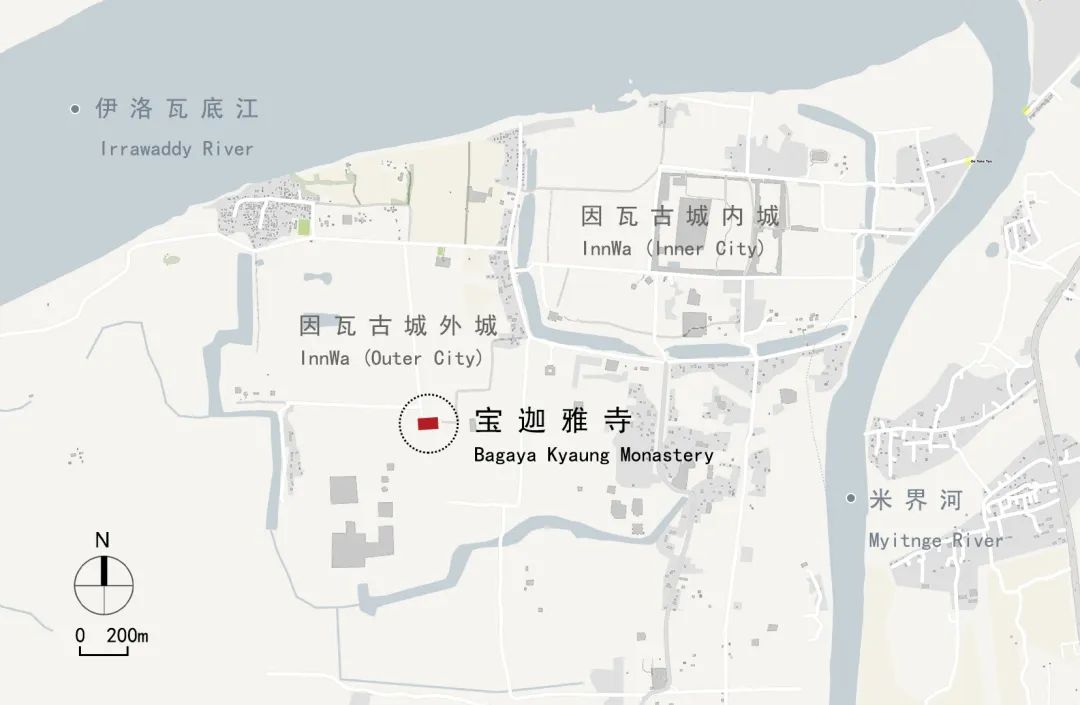
图1 宝迦雅寺区位示意图(来源:东南大学团队自绘)
Figure 1. Location of Bagaya Kyaung Monastery (Source: Southeast University)
“
02 文化特色
宝迦雅寺是因瓦古城两座具有重要建筑意义的寺庙之一。寺庙的主体建筑分布在为东西轴线上。其中,十字形佛塔神龛亭(称为Pyatthat Hsaung)矗立在石台东侧,其尖塔状佛塔屋顶极具辨识度。向西延伸处设有一间小储藏室,可能曾用于存放佛经手稿。再往西延伸,矗立着整座寺院最宏伟的部分——大佛殿(Hsaung Maw Gyi)。其屋顶最初为木制,在1929年被替换为波纹铁屋顶。建筑采用典型的缅甸层叠式(zei-ta-wun)风格,具有多层退台式结构,每层间以大型矩形板相隔。内部由厚实的木墙划分为东西两室,东侧可能为礼佛正厅,西侧厅则可能被用作僧侣起居修行之所,空间布局更侧重实用性。宝迦雅寺主要以雕刻和花卉蔓藤花纹为装饰。建筑上的小雕塑与鸟兽浮雕,以及墙上带有旋转纹饰的小柱子,反映了阿瓦王朝的典型艺术作品形式。
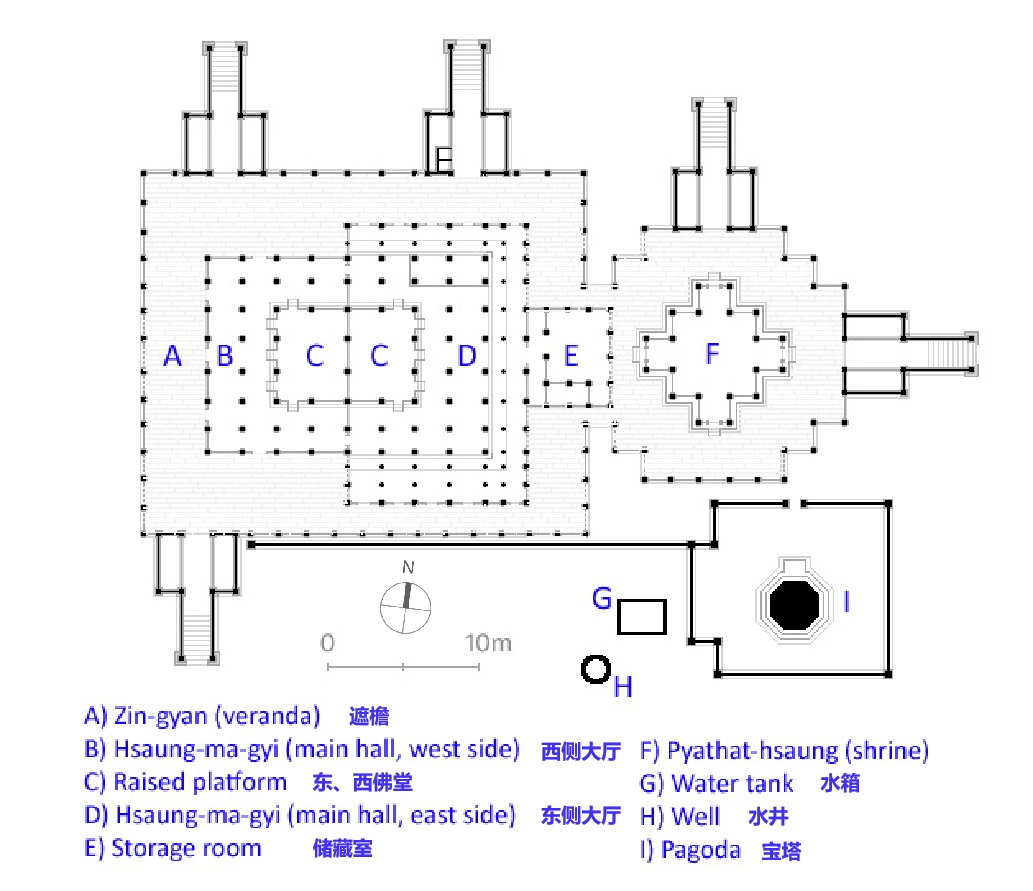
图2 宝迦雅寺平面图(来源:亚洲历史建筑)
Figure 2. Plane Figure of Bagaya Kyaung Monastery
(Source: Asian Historical Architecture)
https://www.orientalarchitecture.com/sid/1289/myanmar/inwa/bagaya-kyaung-monastery
“
03 损毁情况
据缅甸社交媒体、震区群众相关消息,本次强震导致宝迦雅寺的室外台阶受损,南墙倒塌,主体建筑虽未受到明显破坏,但其内部结构损伤程度需进一步排查。宝迦雅寺为柚木结构,支撑起建筑主体的267根柚木柱位于石基座之上。木构建筑的结构特性使其在地震时能够吸收一定的能量,具有一定的抗震韧性。

图3宝迦雅寺震前照片(来源:亚洲历史建筑)
Figure 3. Photo before earthquake
(Source: Asian Historical Architecture)
https://www.orientalarchitecture.com/sid/1289/myanmar/inwa/bagaya-kyaung-monastery
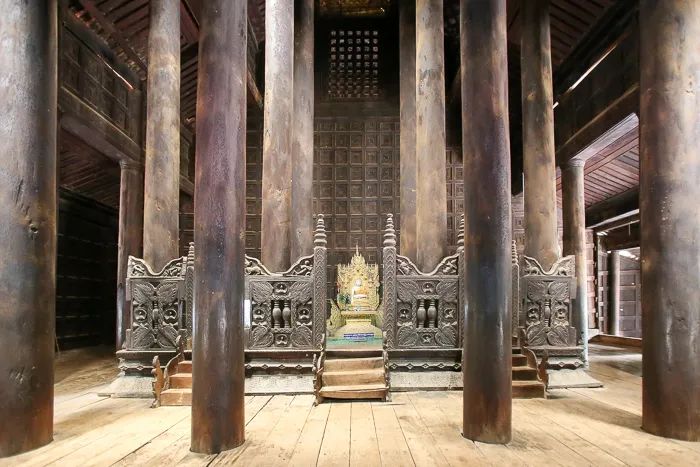
图4宝迦雅寺震前照片(来源:亚洲历史建筑)
Figure 4. Photo before earthquake
(Source: Asian Historical Architecture)
https://www.orientalarchitecture.com/sid/1289/myanmar/inwa/bagaya-kyaung-monastery

图5 宝迦雅寺震前照片(来源:东南大学团队自摄)
Figure 5. Photo before earthquake (Source: Southeast University)
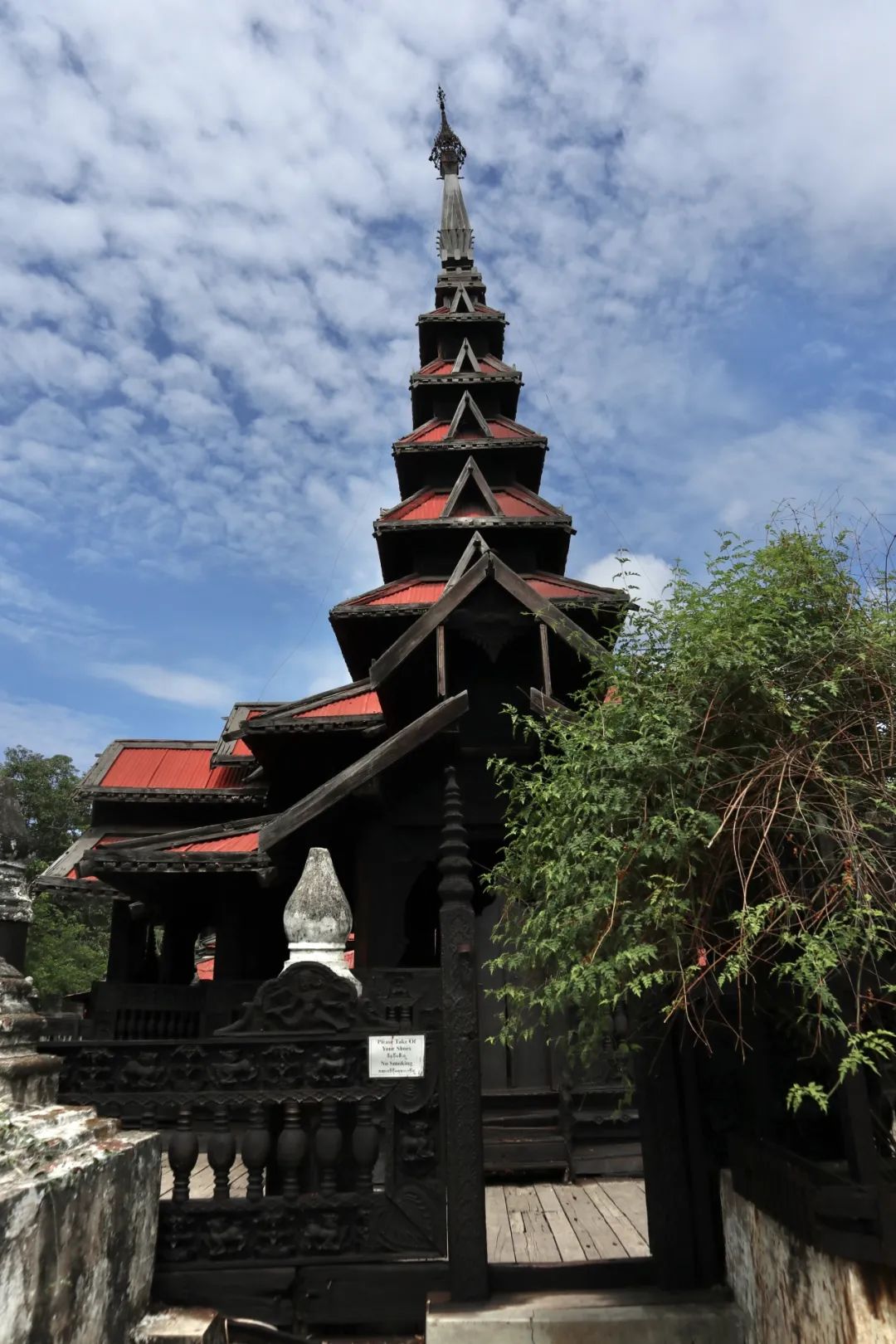
图6 宝迦雅寺震前照片(来源:东南大学团队自摄)
Figure 6. Photo before earthquake (Source: Southeast University)
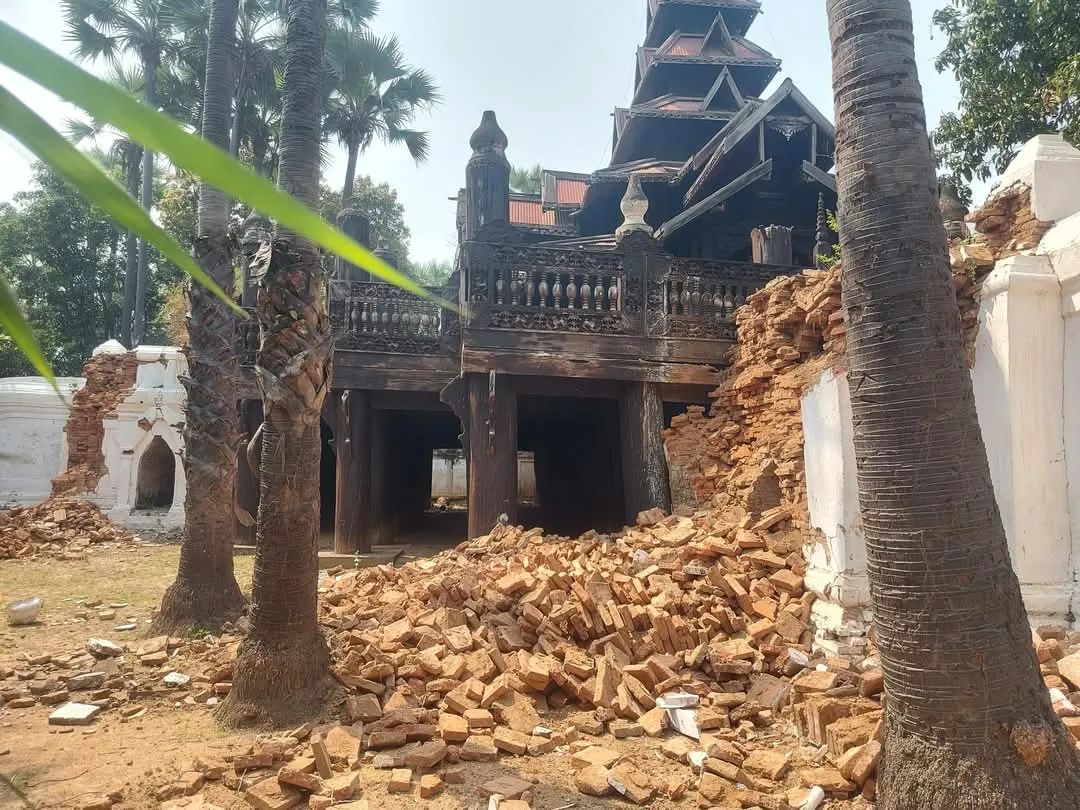
图7 宝迦雅寺震后照片(来源:缅甸当地群众拍摄)
Figure 7. Photo after earthquake (Source: Photo from Local people in Myanmar)
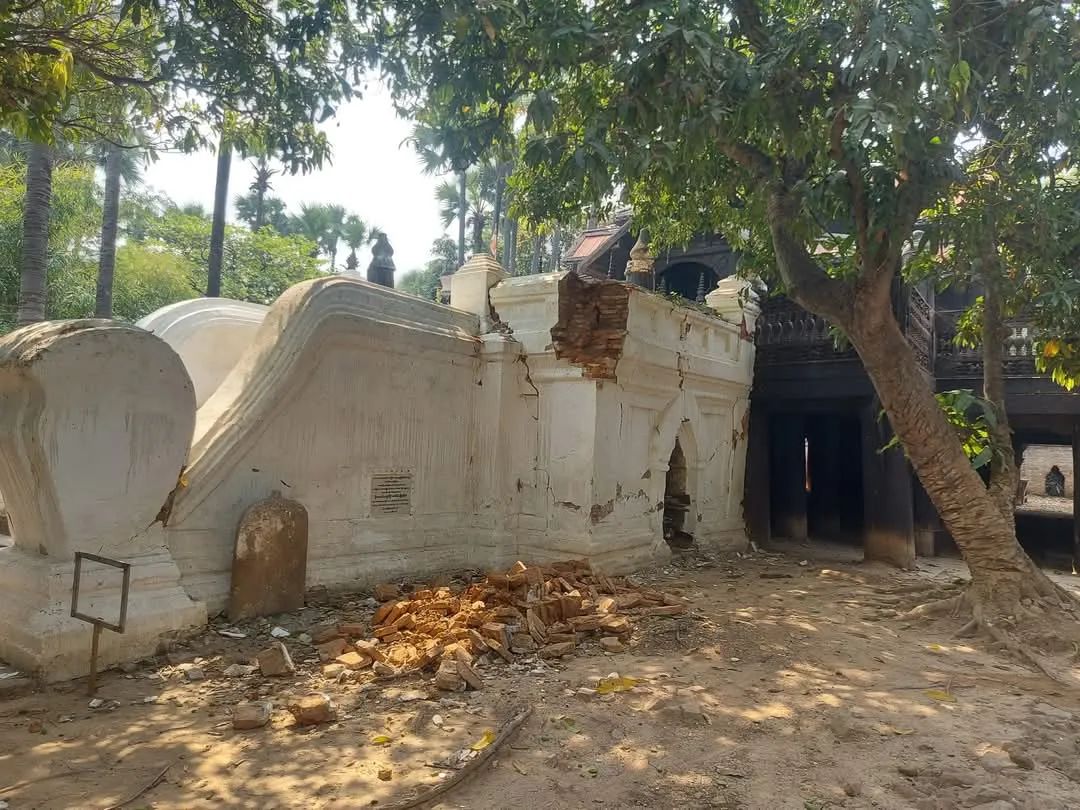
图8 宝迦雅寺震后照片(来源:缅甸当地群众拍摄)
Figure 8. Photo after earthquake (Source: Photo from Local people in Myanmar)

图9 宝迦雅北立面 来源:东南大学团队测绘
(绘图:鞠朵,校核:李金一,测绘成员:陈智深、蒋婉和、鞠朵、翟沛帆,审核:董卫、周小棣、王逸帆)
Figure 9. North elevation of Bagaya Kyaung Monastery
(Source: Mapping from Southeast University)
(Drawn by Ju Duo, Checked by Li Jinyi, Measurements by Chen Zhishen, Jiang Wanhen, Ju Duo, Zhai Peifan, Approved by Dong Wei, Zhou Xiaodi, Wang Yifan)
The following is the English version:
Express News
Post-earthquake Express News on Myanmar's Historical and Cultural Heritage
Foreword
The 7.9-magnitude earthquake that struck on March 28th, 2025 caused heavy losses to Myanmar. According to the latest report, as of April 2nd, the strong earthquake that struck Myanmar on the 28th has resulted in 2886 deaths, with another 4639 injured and approximately 373 missing. We extend our deepest condolences to all the victims.
The earthquake also dealt a devastating blow to numerous cultural heritage sites along the Mandalay - Sagaing - Naypyitaw region, with about 670 temples and 290 pagodas damaged. Important structures such as the King Palace, Mahamuni Pagoda, Me Nu Oak Kyaung, Innwa Bridge have suffered severe damage or been reduced to ruins. Hundreds of stupas and temples collapsed. The survival of the common cultural heritage of mankind is facing a severe test.
To this end, the Asian Academy for Heritage Management has released a series of "Post-earthquake Express News on Myanmar's Historical and Cultural Heritages", calling on the global community to pay attention to the precious value of Myanmar's historical and cultural heritages and the damages condition after the earthquake, and jointly protect the treasures of human civilization.
01
Post-earthquake Express News of Bagaya Kyaung Monastery
“
01 Heritage Overview
Bagaya Kyaung is a teak wood monastery located 600 meters southwest of the former walled city of Innwa (Ava). The site is widely believed to have been first constructed during the reign of King Min Klaung (1401–1422) of the Ava dynasty, though its current structures likely date to the early-to-mid 19th century. The monastery’s roof features three tiers, and its interior spire consists of seven layers. The entire building rests on 267 teak posts, with the largest having a circumference of approximately 3 meters. All posts are uniformly 18 meters in height. The monastery’s layout is notably spacious, measuring roughly 57 meters in length and 31 meters in width.
“
02 Cultural Features
Bagaya Kyaung Monastery is one of the two most architecturally significant monasteries in Innwa. The main buildings of Bagaya Kyaung Monastery are laid out along an east-west axis. Its cruciform-shaped shrine pavilion (called a Pyatthat Hsaung) stands on the east side of the platform, crowned by a spire-like pyatthat roof. Further west lies a small storeroom which may once have housed palm leaf Buddhist manuscripts. The largest and tallest section of the monastery, known as the Hsaung Maw Gyi, is situated further to the west. Originally constructed with a wooden roof, but was replaced by corrugated iron in 1929. The roof is designed in the zei-ta-wun style, featuring multiple receding tiers separated by large rectangular panels. The interior is divided into two east-west rooms by a sturdy wooden wall. The eastern side of the Hsaung Maw Gyi likely served as a reception hall, while the western side was probably used by monks as a dormitory and study area, and its internal decoration is more spare as the room. The monastery’s primary decorative elements include intricate carvings and floral arabesques. Embellishments such as small sculptures, animal and bird reliefs, and wall-mounted posts adorned with lathe-turned ornaments represent the typical form of artistic work in Ava Era.
“
03 Damages Condition
According to reports from Myanmar social media and local residents in the affected area, the recent powerful earthquake damaged the stairs to the Bagaya Kyaung Monastery and caused the southern wall to collapse. While the main structure of the Bagaya Kyaung Monastery was not significantly damaged, the extent of internal structural damage requires further investigation. The mortise-and-tenon joints in wooden architecture allow the structure to absorb energy during earthquakes, demonstrating a degree of seismic resilience.
END
图片来源:亚洲遗产管理学会
文字来源:亚洲遗产管理学会
学术支持:城市与建筑遗产保护教育部重点实验室(东南大学)
中国城市规划学会城市规划历史与理论分会
制作:吴林颖 王子郁
排版:陈君
审核:汪艳
审定:董卫 江泓

扫码关注
亚洲遗产管理学会
Asian Academy for
Heritage Management
Express News
缅甸历史文化遗产震后速报
引言 | Foreword
2025年3月28日发生的7.9级强震致使缅甸遭遇重大损失,据最新通报,截至4月2日,缅甸28日发生的强震已造成2886人遇难,另有4639人受伤,约373人失踪,我们向所有遇难者致以沉痛的哀悼。地震也对缅甸曼德勒-实皆-内比都沿线众多的文化遗产造成了毁灭性打击,约670座寺庙损毁、290座佛塔倾覆,曼德勒皇宫、马哈牟尼佛寺、梅努寺、阿瓦大桥等重要建筑损毁严重或变为废墟。数百座佛塔、寺庙坍塌,人类共同文化遗产存续正面临严峻考验。
为此,亚洲遗产管理学会特发布系列“缅甸历史文化遗产震后速报”,呼吁全球社会关注缅甸历史文化遗产的珍贵价值及震后损毁情况,共同守护人类文明的瑰宝。
02
宝迦雅寺震后速报
Post-earthquake Express News of Bagaya Kyaung Monastery
“
01 遗产概况
宝迦雅寺(Bagaya Kyaung Monastery)是一座柚木构筑的寺庙,位于因瓦古城外城中部。据考,该寺始建于阿瓦王朝的明恭(1401-1422)统治时期,但现存建筑建成时间可追溯到19世纪早中期。宝迦雅寺的屋顶有三层,寺内尖顶有七层。整个寺庙由267根柚木柱支撑,最大的柚木柱周长约3米,所有柱子的高度都相同,约为18米。寺院的结构相对宽敞,长约57米,宽约31米。

图1 宝迦雅寺区位示意图(来源:东南大学团队自绘)
Figure 1. Location of Bagaya Kyaung Monastery (Source: Southeast University)
“
02 文化特色
宝迦雅寺是因瓦古城两座具有重要建筑意义的寺庙之一。寺庙的主体建筑分布在为东西轴线上。其中,十字形佛塔神龛亭(称为Pyatthat Hsaung)矗立在石台东侧,其尖塔状佛塔屋顶极具辨识度。向西延伸处设有一间小储藏室,可能曾用于存放佛经手稿。再往西延伸,矗立着整座寺院最宏伟的部分——大佛殿(Hsaung Maw Gyi)。其屋顶最初为木制,在1929年被替换为波纹铁屋顶。建筑采用典型的缅甸层叠式(zei-ta-wun)风格,具有多层退台式结构,每层间以大型矩形板相隔。内部由厚实的木墙划分为东西两室,东侧可能为礼佛正厅,西侧厅则可能被用作僧侣起居修行之所,空间布局更侧重实用性。宝迦雅寺主要以雕刻和花卉蔓藤花纹为装饰。建筑上的小雕塑与鸟兽浮雕,以及墙上带有旋转纹饰的小柱子,反映了阿瓦王朝的典型艺术作品形式。

图2 宝迦雅寺平面图(来源:亚洲历史建筑)
Figure 2. Plane Figure of Bagaya Kyaung Monastery
(Source: Asian Historical Architecture)
https://www.orientalarchitecture.com/sid/1289/myanmar/inwa/bagaya-kyaung-monastery
“
03 损毁情况
据缅甸社交媒体、震区群众相关消息,本次强震导致宝迦雅寺的室外台阶受损,南墙倒塌,主体建筑虽未受到明显破坏,但其内部结构损伤程度需进一步排查。宝迦雅寺为柚木结构,支撑起建筑主体的267根柚木柱位于石基座之上。木构建筑的结构特性使其在地震时能够吸收一定的能量,具有一定的抗震韧性。

图3宝迦雅寺震前照片(来源:亚洲历史建筑)
Figure 3. Photo before earthquake
(Source: Asian Historical Architecture)
https://www.orientalarchitecture.com/sid/1289/myanmar/inwa/bagaya-kyaung-monastery

图4宝迦雅寺震前照片(来源:亚洲历史建筑)
Figure 4. Photo before earthquake
(Source: Asian Historical Architecture)
https://www.orientalarchitecture.com/sid/1289/myanmar/inwa/bagaya-kyaung-monastery

图5 宝迦雅寺震前照片(来源:东南大学团队自摄)
Figure 5. Photo before earthquake (Source: Southeast University)

图6 宝迦雅寺震前照片(来源:东南大学团队自摄)
Figure 6. Photo before earthquake (Source: Southeast University)

图7 宝迦雅寺震后照片(来源:缅甸当地群众拍摄)
Figure 7. Photo after earthquake (Source: Photo from Local people in Myanmar)

图8 宝迦雅寺震后照片(来源:缅甸当地群众拍摄)
Figure 8. Photo after earthquake (Source: Photo from Local people in Myanmar)

图9 宝迦雅北立面 来源:东南大学团队测绘
(绘图:鞠朵,校核:李金一,测绘成员:陈智深、蒋婉和、鞠朵、翟沛帆,审核:董卫、周小棣、王逸帆)
Figure 9. North elevation of Bagaya Kyaung Monastery
(Source: Mapping from Southeast University)
(Drawn by Ju Duo, Checked by Li Jinyi, Measurements by Chen Zhishen, Jiang Wanhen, Ju Duo, Zhai Peifan, Approved by Dong Wei, Zhou Xiaodi, Wang Yifan)
The following is the English version:
Express News
Post-earthquake Express News on Myanmar's Historical and Cultural Heritage
Foreword
The 7.9-magnitude earthquake that struck on March 28th, 2025 caused heavy losses to Myanmar. According to the latest report, as of April 2nd, the strong earthquake that struck Myanmar on the 28th has resulted in 2886 deaths, with another 4639 injured and approximately 373 missing. We extend our deepest condolences to all the victims.
The earthquake also dealt a devastating blow to numerous cultural heritage sites along the Mandalay - Sagaing - Naypyitaw region, with about 670 temples and 290 pagodas damaged. Important structures such as the King Palace, Mahamuni Pagoda, Me Nu Oak Kyaung, Innwa Bridge have suffered severe damage or been reduced to ruins. Hundreds of stupas and temples collapsed. The survival of the common cultural heritage of mankind is facing a severe test.
To this end, the Asian Academy for Heritage Management has released a series of "Post-earthquake Express News on Myanmar's Historical and Cultural Heritages", calling on the global community to pay attention to the precious value of Myanmar's historical and cultural heritages and the damages condition after the earthquake, and jointly protect the treasures of human civilization.
01
Post-earthquake Express News of Bagaya Kyaung Monastery
“
01 Heritage Overview
Bagaya Kyaung is a teak wood monastery located 600 meters southwest of the former walled city of Innwa (Ava). The site is widely believed to have been first constructed during the reign of King Min Klaung (1401–1422) of the Ava dynasty, though its current structures likely date to the early-to-mid 19th century. The monastery’s roof features three tiers, and its interior spire consists of seven layers. The entire building rests on 267 teak posts, with the largest having a circumference of approximately 3 meters. All posts are uniformly 18 meters in height. The monastery’s layout is notably spacious, measuring roughly 57 meters in length and 31 meters in width.
“
02 Cultural Features
Bagaya Kyaung Monastery is one of the two most architecturally significant monasteries in Innwa. The main buildings of Bagaya Kyaung Monastery are laid out along an east-west axis. Its cruciform-shaped shrine pavilion (called a Pyatthat Hsaung) stands on the east side of the platform, crowned by a spire-like pyatthat roof. Further west lies a small storeroom which may once have housed palm leaf Buddhist manuscripts. The largest and tallest section of the monastery, known as the Hsaung Maw Gyi, is situated further to the west. Originally constructed with a wooden roof, but was replaced by corrugated iron in 1929. The roof is designed in the zei-ta-wun style, featuring multiple receding tiers separated by large rectangular panels. The interior is divided into two east-west rooms by a sturdy wooden wall. The eastern side of the Hsaung Maw Gyi likely served as a reception hall, while the western side was probably used by monks as a dormitory and study area, and its internal decoration is more spare as the room. The monastery’s primary decorative elements include intricate carvings and floral arabesques. Embellishments such as small sculptures, animal and bird reliefs, and wall-mounted posts adorned with lathe-turned ornaments represent the typical form of artistic work in Ava Era.
“
03 Damages Condition
According to reports from Myanmar social media and local residents in the affected area, the recent powerful earthquake damaged the stairs to the Bagaya Kyaung Monastery and caused the southern wall to collapse. While the main structure of the Bagaya Kyaung Monastery was not significantly damaged, the extent of internal structural damage requires further investigation. The mortise-and-tenon joints in wooden architecture allow the structure to absorb energy during earthquakes, demonstrating a degree of seismic resilience.
END
图片来源:亚洲遗产管理学会
文字来源:亚洲遗产管理学会
学术支持:城市与建筑遗产保护教育部重点实验室(东南大学)
中国城市规划学会城市规划历史与理论分会
制作:吴林颖 王子郁
排版:陈君
审核:汪艳
审定:董卫 江泓

扫码关注
亚洲遗产管理学会
Asian Academy for
Heritage Management
